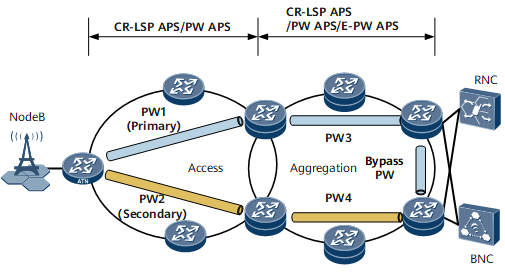Application of Bit-Error-Triggered Protection Switching in a Scenario in Which a Static CR-LSP/PW Carries L2VPN Services
Networking Description
Figure 1 shows a typical IP RAN. L2VPN services are carried on static CR-LSPs. CR-LSP APS is configured to provide tunnel-level protection. Additionally, PW APS/E-PW APS is configured for L2VPN services to provide service-level protection.
Feature Deployment
To meet high reliability requirements of the IP RAN and protect services against bit errors, configure bit-error-triggered protection switching for the CR-LSPs/PWs. To do so, enable bit error detection on the interfaces along the CR-LSPs/PWs, configure the switching type as trigger-LSP, and configure bit error alarm generation and clearing thresholds. If the BER reaches the bit error alarm threshold configured on an interface of a device along a static CR-LSP or PW, the device determines that a bit error occurrence event has occurred and notifies the MPLS-TP OAM module of the event. The MPLS-TP OAM module uses AIS packets to advertise the bit error status to the egress, and then APS is used to trigger a traffic switchover.
